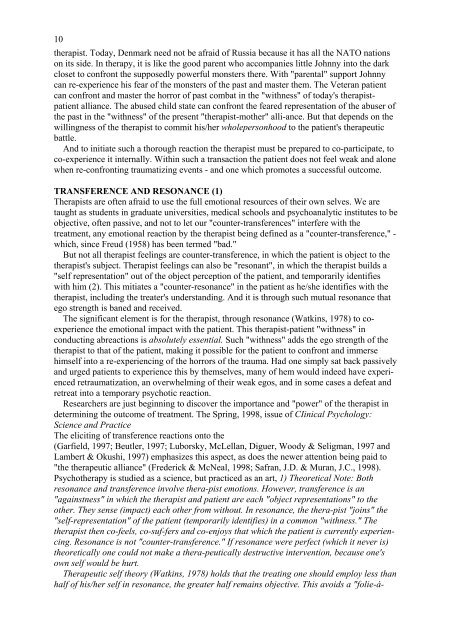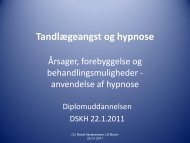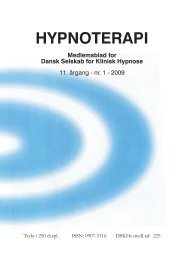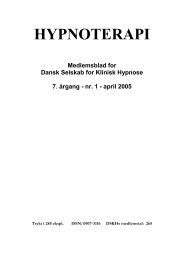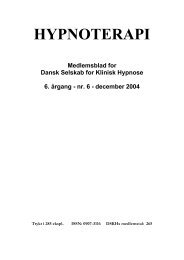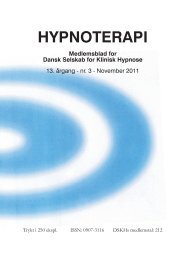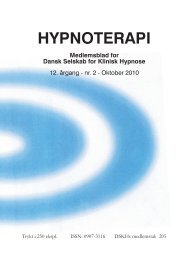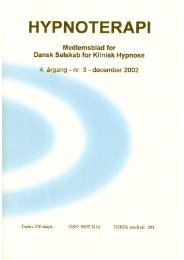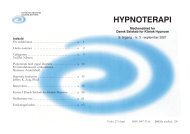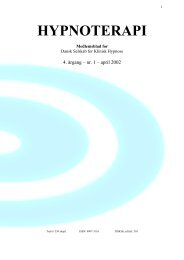HYPNOTERAPl - Dansk Selskab for Klinisk Hypnose
HYPNOTERAPl - Dansk Selskab for Klinisk Hypnose
HYPNOTERAPl - Dansk Selskab for Klinisk Hypnose
Create successful ePaper yourself
Turn your PDF publications into a flip-book with our unique Google optimized e-Paper software.
10<br />
therapist. Today, Denmark need not be afraid of Russia because it has all the NATO nations<br />
on its side. In therapy, it is like the good parent who accompanies little Johnny into the dark<br />
closet to confront the supposedly powerful monsters there. With "parental" support Johnny<br />
can re-experience his fear of the monsters of the past and master them. The Veteran patient<br />
can confront and master the horror of past combat in the "withness" of today's therapistpatient<br />
alliance. The abused child state can confront the feared representation of the abuser of<br />
the past in the "withness" of the present "therapist-mother" alli-ance. But that depends on the<br />
willingness of the therapist to commit his/her wholepersonhood to the patient's therapeutic<br />
battle.<br />
And to initiate such a thorough reaction the therapist must be prepared to co-participate, to<br />
co-experience it internally. Within such a transaction the patient does not feel weak and alone<br />
when re-confronting traumatizing events - and one which promotes a successful outcome.<br />
TRANSFERENCE AND RESONANCE (1)<br />
Therapists are often afraid to use the full emotional resources of their own selves. We are<br />
taught as students in graduate universities, medical schools and psychoanalytic institutes to be<br />
objective, often passive, and not to let our "counter-transferences" interfere with the<br />
treatment, any emotional reaction by the therapist being defined as a "counter-transference," -<br />
which, since Freud (1958) has been termed "bad."<br />
But not all therapist feelings are counter-transference, in which the patient is object to the<br />
therapist's subject. Therapist feelings can also be "resonant", in which the therapist builds a<br />
"self representation" out of the object perception of the patient, and temporarily identifies<br />
with him (2). This mitiates a "counter-resonance" in the patient as he/she identifies with the<br />
therapist, including the treater's understanding. And it is through such mutual resonance that<br />
ego strength is baned and received.<br />
The significant element is <strong>for</strong> the therapist, through resonance (Watkins, 1978) to coexperience<br />
the emotional impact with the patient. This therapist-patient "withness" in<br />
conducting abreactions is absolutely essential. Such "withness" adds the ego strength of the<br />
therapist to that of the patient, making it possible <strong>for</strong> the patient to confront and immerse<br />
himself into a re-experiencing of the horrors of the trauma. Had one simply sat back passively<br />
and urged patients to experience this by themselves, many of hem would indeed have experienced<br />
retraumatization, an overwhelming of their weak egos, and in some cases a defeat and<br />
retreat into a temporary psychotic reaction.<br />
Researchers are just beginning to discover the importance and "power" of the therapist in<br />
determining the outcome of treatment. The Spring, 1998, issue of CIinical Psychology:<br />
Science and Practice<br />
The eliciting of transference reactions onto the<br />
(Garfield, 1997; Beutler, 1997; Luborsky, McLellan, Diguer, Woody & Seligman, 1997 and<br />
Lambert & Okushi, 1997) emphasizes this aspect, as does the newer attention being paid to<br />
"the therapeutic alliance" (Frederick & McNeal, 1998; Safran, J.D. & Muran, J.C., 1998).<br />
Psychotherapy is studied as a science, but practiced as an art, 1) Theoretical Note: Both<br />
resonance and transference involve thera-pist emotions. However, transference is an<br />
"againstness" in which the therapist and patient are each "object representations" to the<br />
other. They sense (impact) each other from without. In resonance, the thera-pist "joins" the<br />
"self-representation" of the patient (temporarily identifies) in a common "withness." The<br />
therapist then co-feels, co-suf-fers and co-enjoys that which the patient is currently experiencing.<br />
Resonance is not "counter-transference." If resonance were perfect (which it never is)<br />
theoretically one could not make a thera-peutically destructive intervention, because one's<br />
own self would be hurt.<br />
Therapeutic self theory (Watkins, 1978) holds that the treating one should employ less than<br />
half of his/her self in resonance, the greater half remains objective. This avoids a "folie-á-


